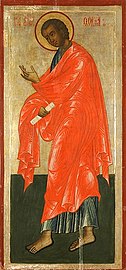Top Qs
Timeline
Chat
Perspective
October 6 (Eastern Orthodox liturgics)
From Wikipedia, the free encyclopedia
Remove ads
October 5 - Eastern Orthodox liturgical calendar - October 7

All fixed commemorations below celebrated on October 19 by Eastern Orthodox Churches on the Old Calendar.[note 1]
For October 6th, Orthodox Churches on the Old Calendar commemorate the Saints listed on September 23.
Saints
Pre-Schism Western saints
- Martyrs of Trier, innumerable martyrs slain for Christ in diverse ways, in Trier in Germany under Diocletian (287)[10][note 3]
- Saint Faith (Foi. Foy), a holy virgin in Agen in the south of France, burnt to death under Maximian Herculeus (3rd century)[10][note 4][note 5]
- Saint Romanus of Auxerre, Bishop of Auxerre in France (564)[10][note 6][note 7]
- Saint Magnus of Oderzo, born in Venice in Italy, he became Bishop of Oderzo on the Adriatic and later of Heraclea (c. 660)[10][note 8]
- Saint Cumine the White, born in Ireland, he became Abbot of Iona and wrote a life of St Columba (669)[10][12] (see also: February 24 )
- Saint Ceollach, Bishop of the Mercians or Mid-Angles, before going to Iona and then returning to Ireland (7th century)[10][note 9]
- Saint Pardulphus (Pardoux), born in Sardent near Guéret in France, he became a hermit, then went to the monastery of Guéret where he became abbot (c. 738)[10][note 10]
- Saint Aurea, a nun in Boves who became the abbess of a large convent (8th century)[10]
- Saint Epiphania of Pavia, a nun at the convent of Santa Maria della Caccia, in Pavia in Italy (c. 800)[10]
- Adalbero of Würzburg, Bishop (d. 1090).
Remove ads
Post-Schism Orthodox saints
- Venerable Cindeus of Cyprus (Kendeas) the Wonderworker, one of the "300 Allemagne Saints" in Cyprus (12th century).[1][3][8][14][note 11]
- The Holy Six "Allemagne Saints", in Cyprus (12th century):[3][7][17]
- Hilarion the New; John; Joseph, at Lythrodontas; Calantius of Tamassos; Cassianos of Glypha; Cassianos of Axylou.
New Martys and Confessors
Other commemorations
Icon gallery
- Apostle Thomas.
- St. Faith (Foi. Foy).
- St. Innocent of Alaska.
Notes
- The notation Old Style or (OS) is sometimes used to indicate a date in the Julian Calendar (which is used by churches on the "Old Calendar").
The notation New Style or (NS), indicates a date in the Revised Julian calendar (which is used by churches on the "New Calendar"). - "At Treves, the commemoration of almost numberless martyrs, who were put to death for the faith in various manners, under the governor Rictiovarus, in the persecution of Diocletian."[9]
- "DACIANUS, governor of Spain under Diocletian and Maximian, was at one time at Agen, in Aquitania, and hearing that a certain noble damsel, named Faith, living in Agen, was a Christian, he summoned her before his tribunal and ordered her to renounce the faith of the Crucified. "From a child," answered the maiden, "I have served the Lord Jesus Christ with all my heart, and have confessed his name." Dacian produced the ordinary arguments, tried persuasion and threats in vain, and then sentenced her to be stretched over a fire on a brazen grate with her hands and feet tied to four posts. She endured the agony with great fortitude. The executioners raked up the coals under her and poured on fat, and the blaze rushing up enveloped her. According to one version of the Acts, a heavy fall of snow veiled her body as it lay on the burning bed, and the shower only ceased when she was dead. Many other Christians, moved by her heroism, surrendered themselves and were executed with the sword. The arm of S. Faith was anciently shown at Glastonbury. The crypt of S. Paul's Cathedral, London, is dedicated to S. Faith, and was at one time enriched with some of her relics. Her head is shown at Agen. In art S. Faith is represented as a maiden with a palmbranch and a grate."[11]
- See: (in Italian) Romano di Auxerre. Wikipedia. (Italian Wikipedia).
- "ST. CEOLLACH was appointed to succeed St. Diuma as second Bishop of the Mercians and Mid-Angles. Like his predecessor, he was an Irishman, and a monk of St. Columba's Monastery of lona. He administered his diocese but a short time, and then returned to his beloved retreat at lona. The latter period of his life was spent in Ireland, where he is honoured among the native Saints of the country."[13]
- At the time of the Saracen invasion he remained alone in the monastery which he saved through his prayers.
- Venerable Cindeus (Kendeas) is one of the "300 Allemagne Saints" in Cyprus. The 300 Allemagne Saints came to Cyprus from Palestine, and lived as ascetics in various parts of the island. According to some of their lives in the Great Synaxaristes, after the dissolution of the Second Crusade (1147 - 1149), they decided to live the monastic life in the Jordan desert. However since the Latins there disturbed them, they relocated to Cyprus and dispersed over the island.[15][16]
Remove ads
References
Sources
Wikiwand - on
Seamless Wikipedia browsing. On steroids.
Remove ads




